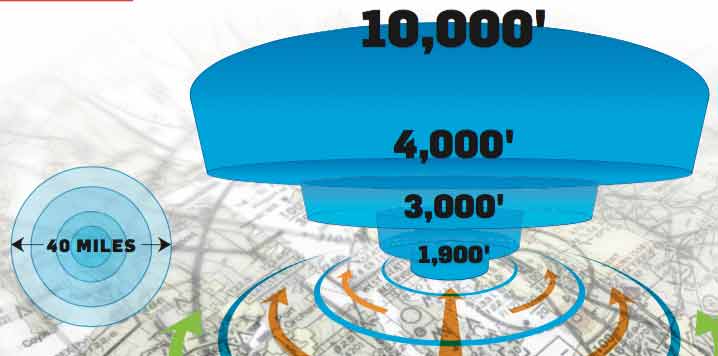
Understanding class B airspace. Photo by Alamy/Illustration by Tim Barker
Relevant Discussion: (FAR 71.41, 91.117, 91.126, 91.127, 91.129, 91.130, 91.131, 91.155, 91.215, AIM 3-2-1, 3-2-3)
Class B Airspace:
Surface to 7,000 feet msl (e.g., in Miami) or up to as high as 12,500 feet msl (e.g., Atlanta) surrounding the busiest airports. (The illustration above is an example only.)
Individually tailored upside-down wedding cakes — and contain all instrument approaches.
The word "cleared" into Class B is required before entering.
All operations require a two-way radio.
Airports listed in section 4, appendix D, of Part 91 require at least a private pilot certificate.
Solo student, sport and recreational pilot operations are not permitted at these locations.
VFR operations — Ceiling: 1,000 feet — Visibility: 3 sm — Clear of clouds (or special VFR).
IFR operations — An operable VOR or tacan receiver, or an operable and suitable RNAV system.
Unless otherwise authorized by ATC, a large, turbine-powered airplane (more than 12,500 pounds) operating to or from a primary airport in Class B airspace must operate at or above the floors of the Class B while within the lateral limits of that area, even when operating on a visual approach.
A large (more than 12,500 pounds) or turbine-powered airplane shall, unless otherwise required by distance from cloud criteria, enter the traffic pattern at an altitude of at least 1,500 feet agl and maintain 1,500 feet agl until further descent is required for a safe landing. (This is a noise-abatement consideration.)
A large or turbine-powered airplane approaching to land on a runway served by an instrument approach with vertical guidance (e.g., ILS, LPV, GLS), if the airplane is so equipped, must fly at or above the glidepath between the published final approach fix and the decision altitude (DA) or decision height (DH) as applicable.
Any airplane approaching to land on a runway served by a VASI shall maintain at or above the glidepath until a lower altitude is necessary for a safe landing.
Mode C veil — All aircraft operating within 30 nm of a Class B airport, from the surface to 10,000 feet msl, must have Mode C (unless the aircraft was originally certified without an electrical system and still does not have one).
After January 1, 2020, the applicable automatic dependent surveillance-broadcast Out (ADS-B Out) equipment specified in 91.225 will be required above and within 30 nm of a Class B airport.
Speed limit: 250 kias below 10,000 feet msl (200 kias below the Class B floor or in a VFR corridor).
a. 250 kias must not be exceeded even if you are told to “maintain best forward speed.” That is, unless your aircraft flight manual says your airplane will fall out of the sky at such a ridiculously slow airspeed.
b. “Maintain best forward speed” means maximum or best forward legal speed. ATC does not have the authority to lift the 250-kias-below-10,000-feet speed restriction [91.117(a)]. You cannot be cleared to violate a regulation, and you cannot accept such a clearance. If a controller assigns you 300 knots or greater inbound (10,000 feet or above), and later descends you to 8,000 feet, it is understood that you must slow to 250 kias before descending below 10,000.
“At or above the glideslope” does not prohibit normal bracketing maneuvers above or below the glideslope for the purpose of remaining on the glideslope. “Normal bracketing maneuvers” are maneuvers that remain within the limits of the higher and lower glideslope signals. Commercial turbo-jet operations — OpSpec C077: To accept a visual approach, the airport must be VFR, and the crew must remain within Class B airspace and maintain the basic cloud clearance specified in 91.155.
Do you have to hear the words “cleared into Class B” when VFR?
The short answer is yes. You must hear the magic word "cleared" at least somewhere in the instructions from the approach controller. Radar identification and instructions to maintain a specific altitude and heading that will put you in their airspace can no longer be considered an implicit, implied or understood clearance into Class B (although it happens all the time).
If you can get a word in, ask for confirmation, just to get it on the tape.
That being said, if you've been radar identified by the approach control having jurisdiction (e.g., Charlotte Approach. Note: "Flight following" from "center" cannot clear you into Class B.), the terms "cleared as requested" or even "proceed as requested," or a clearance to a specific point inside the Class B will also suffice. Example: "Citation 5MC, radar contact, cleared direct Charlotte, climb and maintain four thousand, expect 36R."
91.131 (a)(1) "The operator must receive an ATC clearance from the ATC facility having jurisdiction for that area before operating an aircraft in that area." It does not state the operator must specifically hear the magic words "cleared into Class B" in that precise order. If the frequency is saturated and you're paranoid about it, turn around and run away. Now that will get their attention!
FAA regulations could change at any time. Please refer to current FARs to ensure you are legal.

Sign-up for newsletters & special offers!
Get the latest FLYING stories & special offers delivered directly to your inbox






